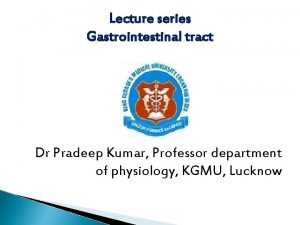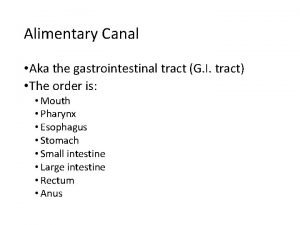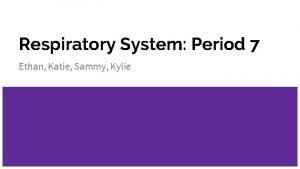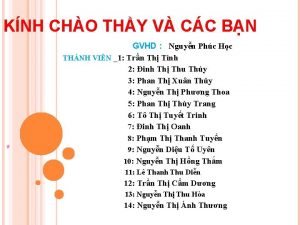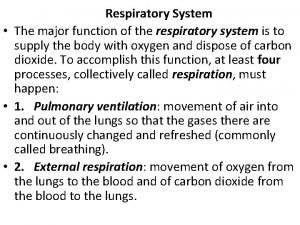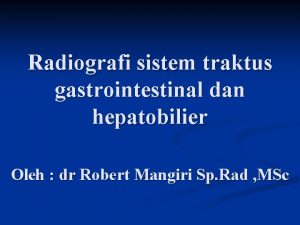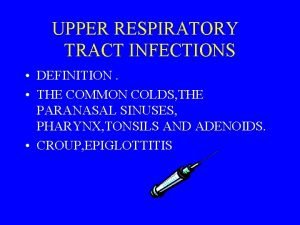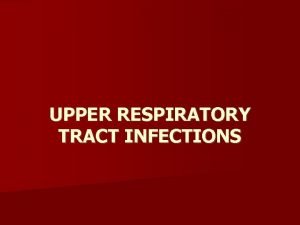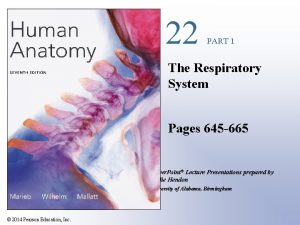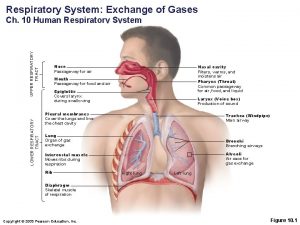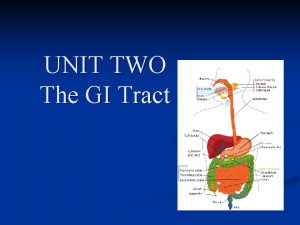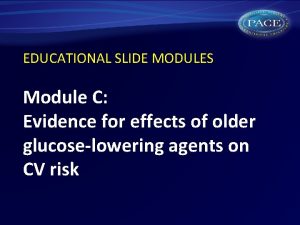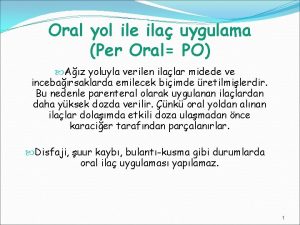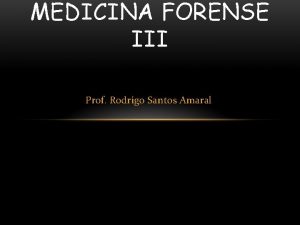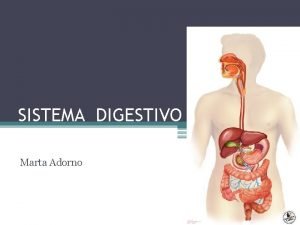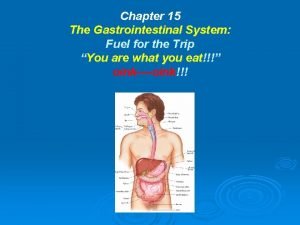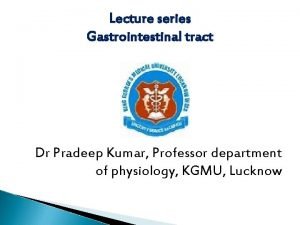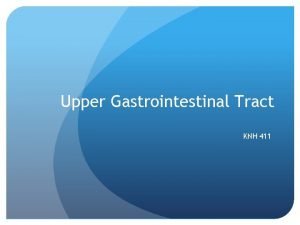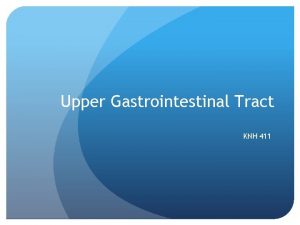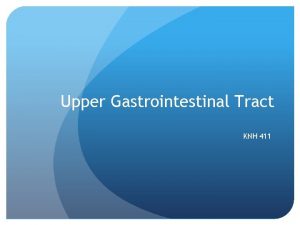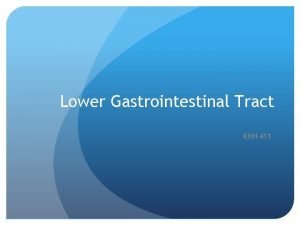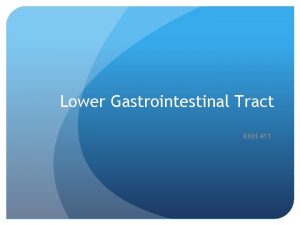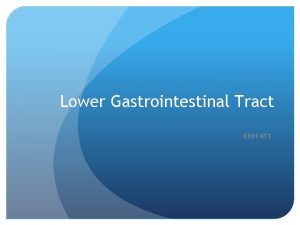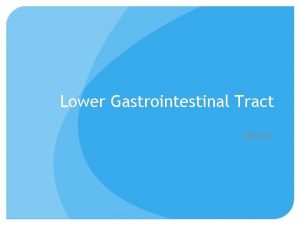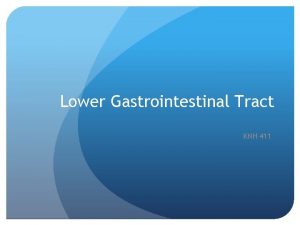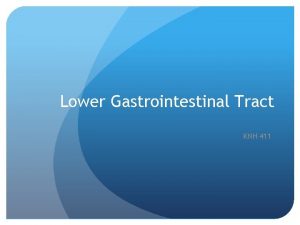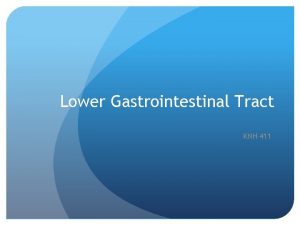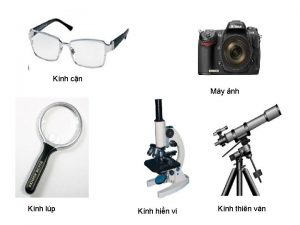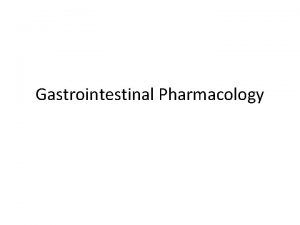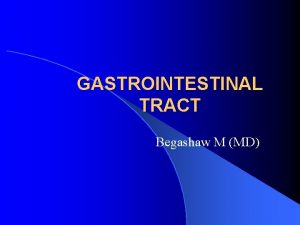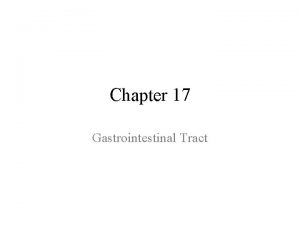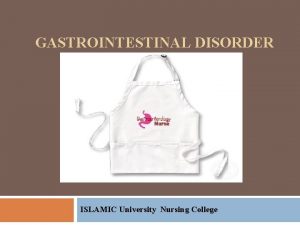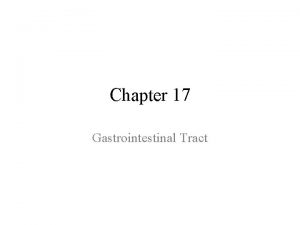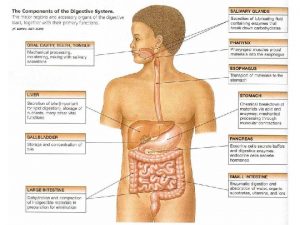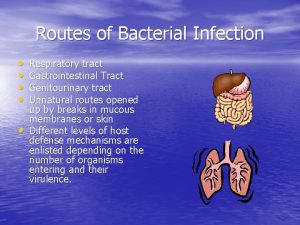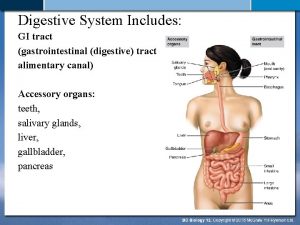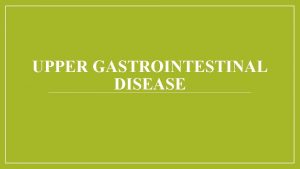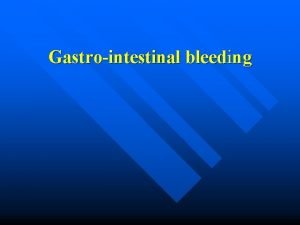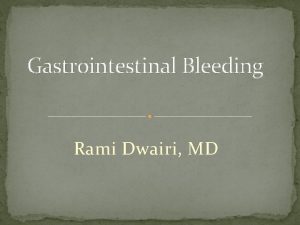Upper Gastrointestinal Tract KNH 411 Upper GI AP






























- Slides: 30

Upper Gastrointestinal Tract KNH 411


Upper GI – A&P Stomach - Motility Filling, storage, mixing, emptying 50 m. L empty – stretches to 1000 m. L Pyloric sphincter © 2007 Thomson - Wadsworth



Pathophysiology - Oral Cavity Nutrition Therapy/Evaluation Increase frequency of meals Bland foods served at room temp. Liberal use of fluids Preference for cold and frozen foods Oral hygiene Monitor using food diary, observation, or kcal count Monitor weight gain or maintenance

Pathophysiology - Esophagus GERD - reflux of gastric contents into the esophagus Incompetence of LES Increased secretion of gastrin, estrogen, progesterone Hiatal hernia Cigarette smoking Use of medications Foods high in fat, chocolate, spearmint, peppermint, alcohol, caffeine

Pathophysiology - Esophagus GERD - symptoms Dysphagia Heartburn Increased salivation Belching Pain radiating to back, neck, or jaw Aspiration Ulceration Barrett’s esophagus

Pathophysiology - Esophagus GERD - Treatment Medical management Modify lifestyle factors Medications – 5 classes Surgery Fundoplication Stretta procedure



Pathophysiology - Esophagus GERD - Nutrition Therapy Identify foods that worsen symptoms Assess food intake esp. those that reduce LES pressure, or increase gastric acidity Assess smoking and physical activity Small, frequent meals Weight loss if warranted

Pathophysiology - Esophagus Dysphagia – difficulty swallowing Potential causes – Drooling, coughing, choking Weight loss, generalized malnutrition Aspiration to aspiration pneumonia Treatment requires health care team dg by bedside swallowing, videofluoroscopy, barium swallow

Pathophysiology - Esophagus Dysphagia – Nutrition Therapy Use acceptable textures to develop adequate menu National Dysphagia Diet 1, 2, 3 Use of thickening agents and specialized products Monitor weight, hydration, and nutritional parameters




Hiatal Hernia © 2007 Thomson - Wadsworth

Pathophysiology - Stomach Gastritis Inflammation of the gastric mucosa Primary cause: H. pylori bacteria Alcohol, food poisoning, NSAIDs Symptoms: belching, anorexia, abdominal pain, vomiting Type A - automimmune Type B – H. pylori Increases with age, achlorhydria Treat with antibiotics and medications

Pathophysiology - Stomach Peptic ulcer disease - ulcerations of the gastric mucosa that penetrate submucosa Gastric or duodenal H. pylori NSAIDS, alcohol, smoking Certain foods, genetic link Increased risk of gastric cancer

Pathophysiology - Stomach Peptic Ulcer Disease - Nutrition Restrict only those foods known to increase acid secretion Black and red pepper, caffeine, coffee, alcohol, individually nontolerated foods Consider timing and size of meal Do not lie down after meals Small, frequent meals

© 2007 Thomson - Wadsworth

Pathophysiology - Stomach Gastric Surgery - Nutrition Implications Reduced capacity Changes in gastric emptying & transit time Components of digestion altered or lost Decreased oral intake, maldigestion, malabsorption

Pathophysiology - Stomach Gastric Surgery - Dumping Syndrome Increased osmolar load enters small intestine too quickly from stomach Release of hormones, enzymes, other secretions altered Food “dumps” into small intestine


Pathophysiology - Stomach Gastric Surgery - Dumping Syndrome Early dumping – 10 -20 min. ; diarrhea, dizziness, weakness, tachycardia Intermediate - 20 -30 min. ; fermentation of bacteria produces gas, abdominal pain, etc. Late dumping - 1 -3 hrs. ; hypoglycemia

Pathophysiology - Stomach Gastric Surgery - Dumping Syndrome Other nutritional concerns: vitamin and mineral deficiencies, lack of intrinsic factor, iron deficiency, osteoporosis

Pathophysiology - Stomach Dumping Syndrome - Nutrition “Anti-dumping” diet Slightly higher in protein & fat Avoid simple sugars & lactose Calcium & vitamin D Liquid between meals Small, frequent meals Lie down after meals Assess for weight loss, malabsorption, and steatorrhea

© 2007 Thomson - Wadsworth

 Chemotrypsinogen
Chemotrypsinogen Composition of stomach
Composition of stomach Alimentary canal in order
Alimentary canal in order Gastrointestinal tract
Gastrointestinal tract Olivospinal tract vs tectospinal tract
Olivospinal tract vs tectospinal tract Difference between pyramidal and extrapyramidal tract
Difference between pyramidal and extrapyramidal tract Knh
Knh Kylie knh
Kylie knh Knh
Knh Anatomy of the upper respiratory tract
Anatomy of the upper respiratory tract What is the major function of the respiratory system
What is the major function of the respiratory system Physiology of respiration
Physiology of respiration Upper gi tract
Upper gi tract Hrpangina
Hrpangina Classification of upper respiratory tract infection
Classification of upper respiratory tract infection Structure of the upper respiratory system
Structure of the upper respiratory system Upper rti
Upper rti Upper and lower respiratory tract
Upper and lower respiratory tract Functional constipation vs hirschsprung
Functional constipation vs hirschsprung Gastinoma
Gastinoma Malrotasi traktus gastrointestinal
Malrotasi traktus gastrointestinal Why does metformin cause diarrhea
Why does metformin cause diarrhea Focused gi assessment
Focused gi assessment Emt chapter 18 gastrointestinal and urologic emergencies
Emt chapter 18 gastrointestinal and urologic emergencies Gastrointestinal tüp aracılığıyla ilaç uygulama
Gastrointestinal tüp aracılığıyla ilaç uygulama Lesão corto contusa
Lesão corto contusa Hirschsprung disease nursing management
Hirschsprung disease nursing management A digestão começa na boca
A digestão começa na boca Foregut
Foregut Chapter 15 the gastrointestinal system
Chapter 15 the gastrointestinal system Gastrointestinal structure
Gastrointestinal structure
